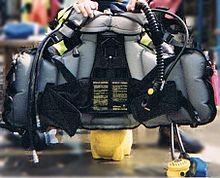
Back صديري غطس Arabic Kompenzátor vztlaku Czech Afbalanceringsvest Danish Tarierweste German Tasapainotusliivi Finnish Gilet de stabilisation French מאזן ציפה HE Perangkat kendali daya-apung ID Giubbotto ad assetto variabile Italian 浮力補償装置 Japanese
 Jacket type BC on diving cylinder | |
| Acronym | BC or BCD |
|---|---|
| Other names | Buoyancy control device |
| Uses | To adjust and control the overall buoyancy of the diver |
| Related items | Backplate and wing |
A buoyancy compensator (BC), also called a buoyancy control device (BCD), stabilizer, stabilisor, stab jacket, wing or adjustable buoyancy life jacket (ABLJ), depending on design, is a type of diving equipment which is worn by divers to establish neutral buoyancy underwater and positive buoyancy at the surface, when needed.
The buoyancy is usually controlled by adjusting the volume of gas in an inflatable bladder, which is filled with ambient pressure gas from the diver's primary breathing gas cylinder via a low-pressure hose from the regulator first stage, directly from a small cylinder dedicated to this purpose, or from the diver's mouth through the oral inflation valve. Ambient pressure bladder buoyancy compensators can be broadly classified as having the buoyancy primarily in front, surrounding the torso, or behind the diver. This affects the ergonomics, and to a lesser degree, the safety of the unit. They can also be broadly classified as having the buoyancy bladder as an integral part of the construction, or as a replaceable component supported inside the structural body.
The buoyancy compensator is one of the items of diving equipment most requiring skill and attention during operation, as control is entirely manual, and adjustment is required throughout the dive as weight reduces due to gas consumption, and buoyancy of the diving suit and BC generally varies with depth. Fine buoyancy adjustment can be done by breath control on open circuit, reducing the amount of actual BC volume adjustment needed, and a skilled diver will develop the ability to adjust volume to maintain neutral buoyancy while remaining aware of the surroundings and performing other tasks. The buoyancy compensator is both an important safety device when used correctly, and a significant hazard when misused or malfunctioning.
The ability to control trim effectively is dependent on both appropriate buoyancy distribution and ballast weight distribution. This too is a skill acquired by practice, and is facilitated by minimising the required BC gas volume by correct weighting.
© MMXXIII Rich X Search. We shall prevail. All rights reserved. Rich X Search